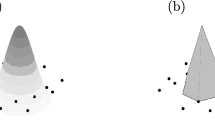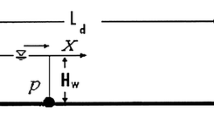Abstract
A 3-D large eddy simulation model that was first transformed to smoothed particle hydrodynamics (LES-SPH)-based model was employed to study breaking tsunami waves in this paper. LES-SPH is a gridless (or mesh-free), purely Lagrangian particle approach which is capable of tracking the free surface of violent deformation with fragmentation in an easy and accurate way. The Smagorinsky closure model is used to simulate the turbulence due to its simplicity and effectiveness. The Sub-Particle Scale scheme, plus the link-list algorithm, is applied to reduce the demand of computational power. The computational results show that the 3-D LES-SPH model can capture well the breaking wave characteristics. Spatial evolution features of breaking wave are presented and visualized. The detailed mechanisms of turbulence transport and vorticity dynamics are demonstrated as well. This application also presents an example to validate the SPH model.











Similar content being viewed by others
References
Battjes JA (1974) Surf similarity. In: Proceedings of 14th coastal engineering conference ASCE, vol 1, pp 466–480
Beeman D (1976) Some multistep methods for use in molecular dynamics calculations. J Comput Phys 20(2):130–139
Colagrossi A, Landrini M (2003) Numerical simulation of interfacial flows by smoothed particle hydrodynamics. J Comput Phys 191:448–475
Crespo AJ, Gomes-Gesteira M, Dalrymple RA (2007) Boundary conditions generated by dynamic particles in SPH methods. CMC Comput Mater Contin 5(3):173–184
Dalrymple RA, Knio O (2000) SPH modeling of water waves. In: Proceedings of coastal dynamics. Lund
Dalrymple RA, Rogers BD (2006) Numerical modeling of water waves with the SPH method. Coast Eng 53:141–147
Goring D, Raichlen F (1980) The generation of long waves in the laboratory. In: Proceedings of the 17th coastal engineering conference, American Society of civil engineers, vol 1, pp 763–783
Gotoh H, Shibihara T, Sakai T (2001) Sub-particle-scale model for the MPS method—Lagrangian flow model for hydraulic engineering. Comput Fluid Dyn J 9(4):339–347
Grilli ST, Sevnden IA, Subramanya R (1997) Breaking criterion and characteristics for solitary waves on slopes. J Waterway Port Coast Ocean Eng 123(3):102–112
Hirt CW, Nichols BD (1981) Volume of fluid (VOF) method for the dynamics of free boundaries. J Comput Phys 39(1):201–225
Kennedy AB, Chen Q, Kirby JT, Dalrymple RA (2000) Boussinesq modeling of wave transformation, breaking and runup I 1D. J Waterway Port Coast Ocean Eng 126:39–47
Khayyer A, Gotoh H, Shao SD (2008) Corrected Incompressible SPH method for accurate water-surface tracking in breaking waves. Coast Eng 55:236–250
Leimkuhler B, Reich S, Skeel RD (1996) Integration methods for molecular dynamic. IMA Vol Math Appl 82:161
Li Y (2000) Tsunamis: non-breaking and breaking solitary wave run-up. Rep. KH-R-60, W. M. Keck laboratory of hydraulics and water resources. California Institute of Technology, Pasadena, CA
Li Y, Raichlen F (2003) Energy balance model for breaking solitary wave runup. J Waterways Ports Coast Ocean Eng ASCE 129(2):47–59
Lin PZ, Liu PLF (1998) A numerical study of breaking waves in the surf zone. J Fluid Mech 359:239–264
Liu GR, Liu MB (2003) Smoothed particle hydrodynamics: a meshfree particle method. World Scientific, Singapore, p 472
Lo E, Shao SD (2002) Simulation of near-shore solitary wave mechanics by an incompressible SPH method. Appl Ocean Res 24:275–286
Madsen PA, Sorensen OR, Schaffer HA (1997) Surf zone dynamics simulated by a Boussinesq model, I. Model description and cross-shore motion of regular waves. Coast Eng 32:255–287
McCowan J (1894) On the highest wave of permanent type. Philos Mag 38:351–357
Monaghan JJ (1989) On the problem of penetration in particle methods. J Comput Phys 82(1):1–15
Monaghan JJ (1992) Smoothed particle hydrodynamics. Annu Rev Astron Astrophy 30:543–574
Monaghan JJ (1994) Simulating free surface flows with SPH. J Comput Phys 110:399–406
Monaghan JJ (2005) Smoothed particle hydrodynamics. Rep Prog Phys 68:1703–1759
Monaghan JJ, Kos A (1999) Solitary waves on a Cretan beach. J Waterway Port Coast Ocean Eng 125(3):145–154
Rogers BD, Dalrymple RA (2008) SPH modeling of tsunami waves, advances in Coastal and ocean engineering, vol 10. Advanced numerical models for tsunami waves and runup. World Scientific, Singapore
Shao SD, Ji CM (2006) SPH computation of plunging waves using a 2-D sub-particle scale (SPS) turbulence model. Int J Numer Methods Fluids 51:913–936
Svendsen IA (1984) Wave heights and setup in a surfzone. Coast Eng 8:303–329
Svendsen IA, Veeramony J, Bakunin J, Kirby JT (2000) Analysis of the flow in weakly turbulent hydraulic jumps. J Fluid Mech 418:25–57
Synolakis CE (1990) Generation of long waves in laboratory. J Waterway Port Coast Ocean Eng Am Soc Civil Eng 116(2):252–266
Ting FC, Kirby JT (1995) Dynamics of surf-zone turbulence in a strong plunging breaker. Coast Eng 24:177–204
Verlet L (1967) Computer “experiments” on classical fluids: I. Thermo-dynamical properties of Lennard–Jones molecules. Phys Rev 159:98–103
Watanabe Y, Saeki H (1996) Numerical analysis of breaking waves, hydraulic engineering software. Comput Mech Publ 4:387–394
Watanabe Y, Saeki H (1999) Three-dimensional large eddy simulation of breaking waves. Coast Eng J 41(3&4):281–301
Wendland H (1995) Computational aspects of radial basis function approximation. Elsevier, Germany
Williams JM (1981) Limiting gravity waves in water of finite depth. Philos Trans R Soc 302:139–188
Xie JS, Nistor I, Murty T, Shukla T (2007) Numerical modelling of the Indian Ocean tsunami—a review. Int J Ecol Dev IJED 3(S05):71–88
Author information
Authors and Affiliations
Corresponding author
Rights and permissions
About this article
Cite this article
Xie, J., Nistor, I. & Murty, T. A corrected 3-D SPH method for breaking tsunami wave modelling. Nat Hazards 60, 81–100 (2012). https://doi.org/10.1007/s11069-011-9954-x
Received:
Accepted:
Published:
Issue Date:
DOI: https://doi.org/10.1007/s11069-011-9954-x




